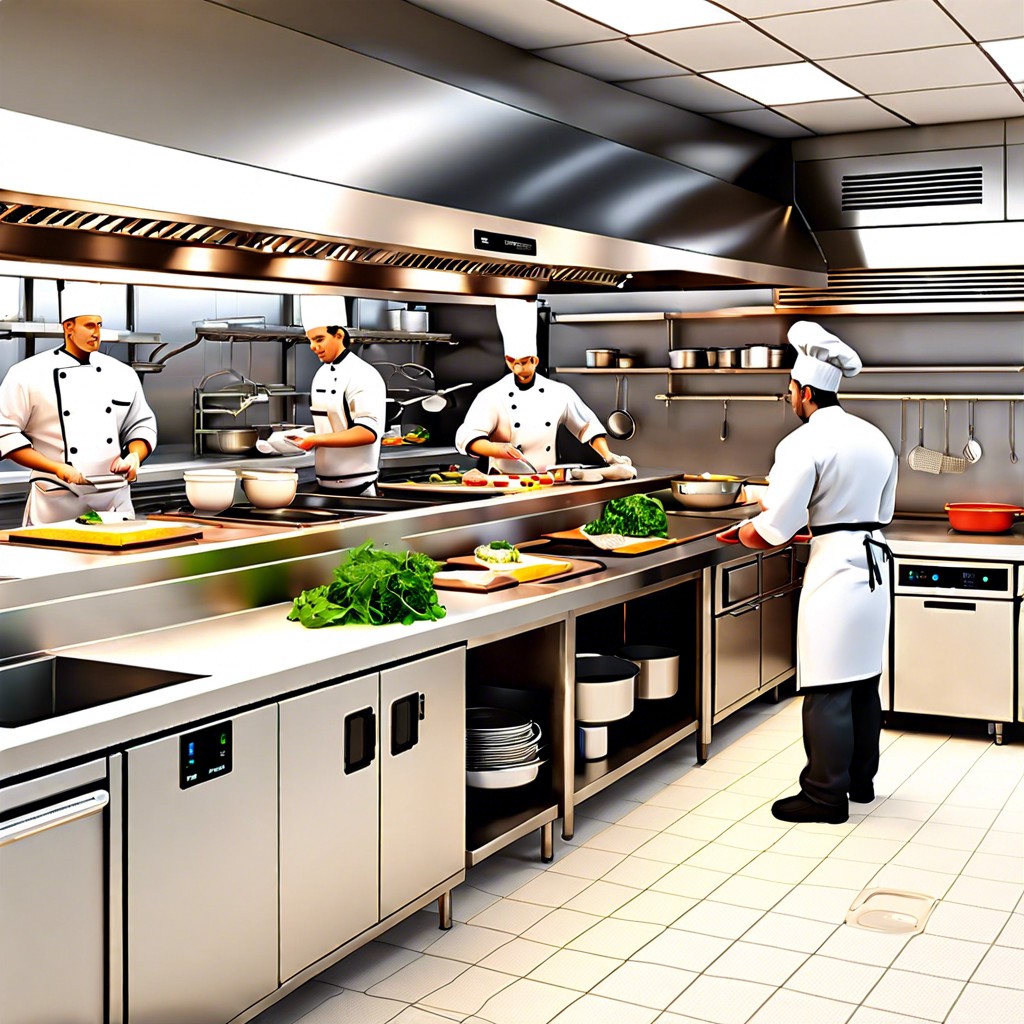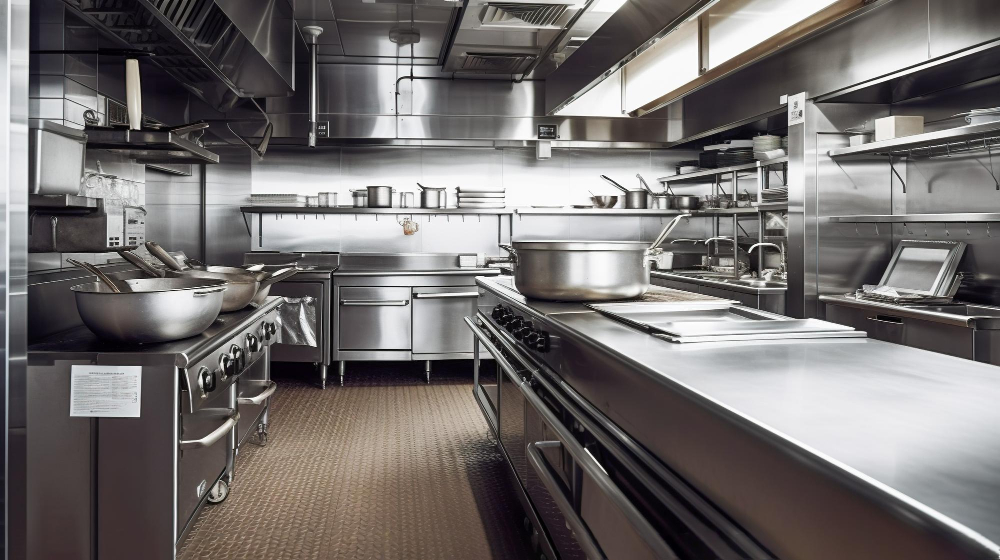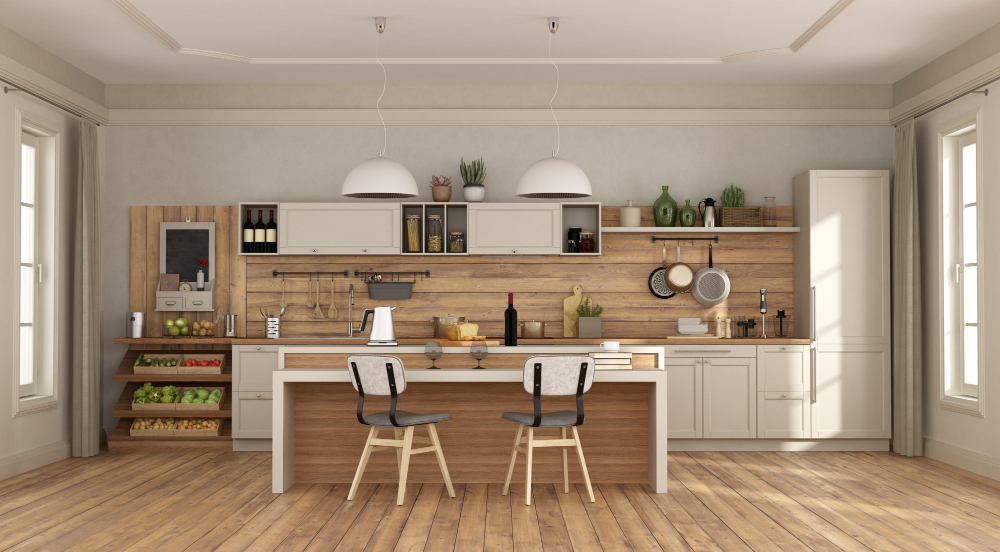Last updated on
Discover what a commercial kitchen is, its essential features, and why it’s the backbone of the culinary industry.
Key takeaways:
- Commercial kitchens are designed for high volume and efficiency.
- Costs for a commercial kitchen can range from tens of thousands to several million dollars.
- The main areas in a commercial kitchen include prep, cooking, cleaning, and storage.
- The prep area is the kitchen’s backbone, tailored for efficiency and safety.
- The cooking area is where culinary creations come to life.
What's Inside
What Is a Commercial Kitchen: Definition, Costs & Workflow

At the heart of every food service establishment is the commercial kitchen, a bustling hub designed for high volume, efficiency, and food safety. Unlike a home kitchen, this powerhouse is equipped to serve potentially hundreds or even thousands of diners each day.
Costs are a significant consideration here, and they vary widely based on size, equipment, and intended use. Initial investments can range from tens of thousands to several million dollars. Operating costs then include energy, labor, maintenance, and the ever-important food safety compliance.
Workflow is meticulously designed to maximize productivity and minimize cross-contamination risk. Every aspect of the layout is strategically planned to create a smooth transition from food storage to prep stations, to the cooking line, and eventually to the dishwashing area. Employees are trained to move within this space, adhering to proper food handling procedures and ensuring a seamless operation from the moment ingredients enter the kitchen to the final presentation of a dish.
Main Areas in a Commercial Kitchen
Diving straight into the operational zones, each area within a commercial kitchen serves a pivotal role in food service efficiency.
The prep area is the heart of food creation, where raw ingredients are transformed through chopping, marinating, and seasoning. It’s typically equipped with cutting tables, mixers, blenders, and food processors.
Moving to the cooking area, this zone features an arsenal of heat-centric appliances like ranges, grills, and fryers. It’s the hive of activity where chefs orchestrate their culinary magic, from searing steaks to sautéing vegetables.
Keeping things spick and span, the cleaning area ensures hygiene with industrial sinks, dishwashers, and drying racks. This space is not just for dishware but also for cleaning utensils and cooking equipment.
Lastly, storage is essential for efficiency and food safety, accommodating dry goods, perishables, and non-food items. Walk-in refrigerators, shelving units, and freezers all play a role in preserving ingredients and organizing supplies.
Thoughtfully allocated, these areas ebb and flow to maintain the rhythm of a commercial kitchen dance, ensuring a performance that meets the high tempo demands of the culinary industry.
Prep Area
The prep area is the kitchen’s backbone, tailored for efficiency and safety. Here, chefs perform the intricate dance of chopping, marinating, and assembling ingredients before they make their journey to the cooking stations. This zone is, in essence, a culinary launchpad, designed with ample counter space for meal prepping tasks, including sorting, seasoning, and portioning.
One will find a collection of commercial-grade equipment dedicated to streamlining the prep process. Picture stainless steel worktables, robust cutting boards, industrial mixers, and blenders—all meticulously arranged to minimize unnecessary movement. Sinks are strategically placed for washing produce, with cutting stations nearby to transition smoothly from rinsing to chopping.
Storage plays a critical role in this area. Ingredients must be accessible, yet out of the way to avoid clutter. Think about refrigerated drawers and shelves within arm’s reach or storage racks with clearly labeled containers that hold prepped items awaiting their turn in the spotlight. The layout mirrors a well-orchestrated ballet, ensuring that every action is both purposeful and efficient.
Keeping the prep area clutter-free and sanitized is paramount. It’s a zone where cleanliness can make or break a kitchen’s reputation and, more importantly, its adherence to food safety standards. Chefs must work seamlessly, maintaining a spotless environment while preparing dishes that will delight the palate.
Cooking Area
At the heart of any commercial kitchen, the cooking area is where culinary creations come to life. This space is meticulously organized with stations designated for various cooking methods—grilling, frying, sautéing, and boiling. The arrangement is strategic to facilitate an efficient workflow, that allows chefs to move smoothly between tasks without cross-contamination of flavors or ingredients.
Heat-resistant surfaces and powerful ventilation systems are key features here, ensuring a safe environment that can withstand the high-heat and long hours of operation. High-grade, industrial equipment, from stoves and grills to deep fryers and sous-vide machines, all find a home within this zone. These appliances are built to endure heavy use and are generally larger than their residential counterparts to accommodate the volume of food being prepared.
Within this hub, you’ll find chefs quick at work, constantly adjusting to the tempo of meal orders. Sous chefs may be seen expertly manning the sauté station, while pastry chefs apply the finishing touches to desserts. The layout is designed not only for cooking efficiency but also for maximum communication and collaboration among kitchen staff.
In summary, the cooking area is a dynamic, bustling environment where precision, speed, and culinary expertise come together, demonstrating the theater of professional cookery.
Cleaning Area
Efficiency and sanitation are paramount in the cleaning area, often referred to as the dish pit. This space is typically equipped with industrial sinks, dishwashers, and drying racks to handle the continuous flow of dirty dishes, pots, and utensils. Here are key points about this essential zone:
- High-Volume Dishwashing: Commercial dishwashers are the workhorses, designed to clean quickly and meet health standards. Unlike household models, these can complete a wash cycle in a matter of minutes.
- Three-Compartment Sinks: Crucial for manual washing, rinsing, and sanitizing. They’re also a health code requirement in many areas, ensuring that items are properly cleaned if a machine malfunction occurs.
- Waste Disposal: Proper waste management systems, including garbage disposals and grease traps, are installed to prevent clogs and maintain a hygienic environment.
- Storage for Clean Dishes: Ample shelving and storage solutions are necessary. Positioning them close to the dishwasher minimizes the distance staff need to transport heavy, clean items.
- Chemical Storage and Safety: Cleaning agents must be stored separately to avoid contamination, with clear labeling and easy access for staff.
Remember, the layout of the cleaning area should promote a clear flow from dirty to clean without any cross-contamination, ensuring a seamless cycle of service items for the kitchen and ultimately, the customer.
Continue reading:



